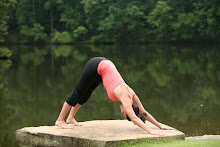The research is in: Here are six of the most potent weapons against the big C.
To reduce your risk of cancer, look no further than your fridge. "All the studies on cancer and nutrition point to eating plant-based foods for their phytonutrients and other special compounds," says Richard Beliveau, PhD, chair in the prevention and treatment of cancer at the University of Quebec at Montreal and author of Foods to Fight Cancer. Aim for five to nine daily servings of all kinds of fruits and vegetables - especially these six superstars.
 Broccoli
BroccoliAll cruciferous veggies (think cauliflower, cabbage, kale) contain cancer-fighting properties, but broccoli is the only one with a sizable amount of sulforaphane, a particularly potent compound that boosts the body's protective enzymes and flushes out cancer-causing chemicals. A recent University of Michigan study on mice found that sulforaphane also targets cancer stem cells - those that aid in tumor growth.
Helps fight: breast, liver, lung, prostate, skin, stomach, and bladder cancers.
Your RX: The more broccoli, the better, research suggests - so add it wherever you can, from salads to omlets to the top of your pizza.
(Based on research by Jed Fahey, ScD, who studies cruciferous vegetables at the Johns Hopkins Chemoprotection Center)
Berries
All berries are packed with cancer-fighting phytonutrients. But black raspberries, in particular, contain very high concentrations of phytochemicals called anthocyanins, which slow down the growth of premalignant cells and keep new blood vessels from forming (and potentially feeding a cancerous tumor).
Helps fight: colon, esophageal, oral, and skin cancers.
Your RX: Concentrated berry powder is used in studies but a half-cup serving of berries a day may help your health, too.
(Based on research by Gary D. Stoner, PhD, a professor of internal medicine at The Ohio State University College of Medicine)
Tomatoes
This juicy fruit is the best dietary source of lycopene, a carotenoid that gives tomatoes their red hue. And that's good news, because lycopene was found to stop endometrial cancer cell growth in a study in Nutrition and Cancer. Endometrial cancer causes nearly 8,000 deaths a year.
Helps fight: endometiral, lung, prostate, and stomach cancers.
Your RX: The biggest benefits come from cooked tomatoes (think pasta sauce!), since the heating process increases the amount of lycopene your body is able to absorb.
(Based on research by Beliveau)
Walnuts
Their phytosterols (cholesterol-like molecules found in plants) have been shown to block estrogen receptors in breast cancer cells, possibly slowing the cells' growth.
Helps fight: breast and prostate cancers.
Your RX: Munching on an ounce of walnuts a day may yield the best benefits.
(Based on research by Elaine Hardman, PhD, associate professor at Marshall University School of Medicine in Huntington, West Virginia)
Garlic
Eating it may not do your breath any favors, but the protection it offers against digestive cancers just might be worth the smell. Phytochemicals in garlic have been found to halt the formation of nitrosamines, carcinogens formed in the stomach (and in the intestines, in certain conditions) when you consume nitrates, a common food preservative. In fact, the Iowa Women's Health Study found that women with the highest amounts of garlic in their diets had a 50% lower risk of certain colon cancers than women who ate the least.
Helps fight: breast, colon, esophageal, and stomach cancers.
Your RX: Chop a clove of fresh, crushed garlic (crushing helps release beneficial enzymes), and sprinkle it into that lycopene-rich tomato sauce while it simmers.
(Based on research by Beliveau)
Beans
A study out of Michigan State University found that black and navy beans significantly reduced colon cancer incidence in rats, in part because a diet rich in the legumes increased levels of the fatty acid butyrate, which in high concentrations has protective effects against cancer growth. Another study, in the journal Crop Science, found dried beans particularly effective in preventing breast cancer in rats.
Helps fight: breast and colon cancers.
Your RX: Add a serving - a half cup - of legumes a few times a week (either from a can or dry beans that have been soaked and cooked) to your usual rotation of greens or other veggies.
What NOT to eat
While researchers are still trying to determine which foods have the most cancer-preventing benefits, we do know what not to eat if you want to protect yourself, says Cheryl Forberg, RD, author of Positively Ageless.
Animal Fats: Meat, cheese, and butter can be rich in saturated fat, which has been linked to obesity - a big cancer predictor. Opt for leaner protein sources, such as fish, low-fat dairy, and those good-for-you beans.
Processed Meats: A ballpark hot dog or a few slices of bacon once in a while won't kill you, but don't make them a staple of your diet. Some cured meats tend to be high in nitrates and nitrates, preservatives that can, in large amounts, potentially increase your risk of stomach and other cancers.
Excessive Alcohol: Stop after one drink! Too much tipping is associated with an increased risk of cancers of the mouth, esophagus, and breast.
I hope this article was as eye-opening to you as it was to me. Age-old holistic healing at its best.

Article from Health Magazine, November 2010.

 Tantra scholar Rod Stryker says that to truly understand why yoga is so transformative, you first have to understand the concept of transformation. The idea that yoga changes you into someone better than the person you were before is something of a misconception. It is more accurate to say that yoga helps you remove the obstacles that obscure who you really are, that it helps you come into a fuller expression of your true nature. We're not transforming into something we aspire to, we're transforming into the very thing that we are innately: our best Self.
Tantra scholar Rod Stryker says that to truly understand why yoga is so transformative, you first have to understand the concept of transformation. The idea that yoga changes you into someone better than the person you were before is something of a misconception. It is more accurate to say that yoga helps you remove the obstacles that obscure who you really are, that it helps you come into a fuller expression of your true nature. We're not transforming into something we aspire to, we're transforming into the very thing that we are innately: our best Self.





